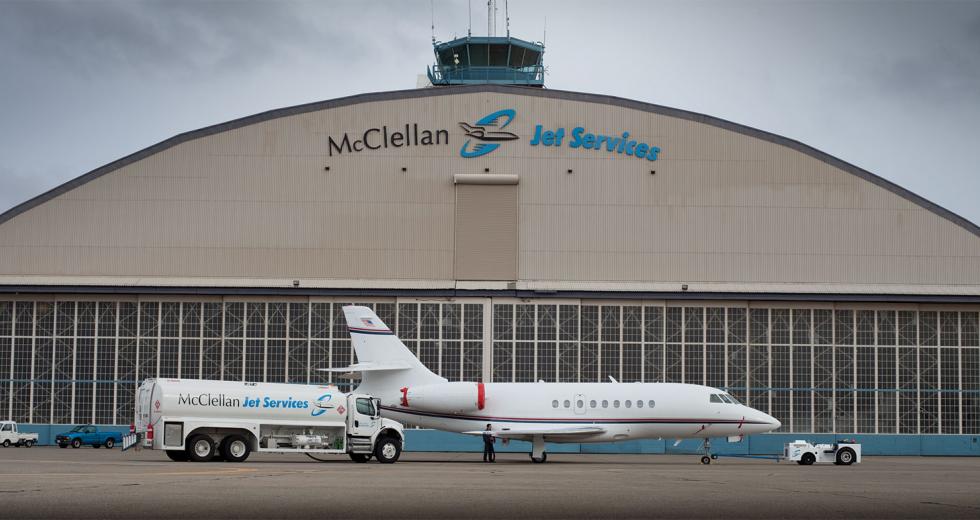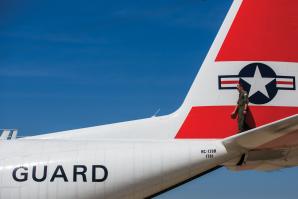McClellan Jet Services is Sacramento’s one-stop shop for all things airplanes.
Whether an aircraft owner wants a wing fixed, a place to stow the plane, a concierge to help find a taxi, hotel or caterer, or just a quick fuel stop, Jet Services will see it gets done. It’s also Sacramento’s only place to offer those services and many more to planes of any size — including 747s — 24 hours a day, seven days a week.
As Scott Owens, senior vice president, puts it: “We are the glorified AM/PM mini-market for business and general aviation aircraft.”
As a full-line fixed base operation, known as an FBO to airport aficionados, Jet Services offers a wide range of services to airplanes and their pilots, passengers and owners. These include refueling, hangar parking, freight and passenger loading and unloading, airplane washing and waxing, refilling oxygen and nitrogen, and even emptying the airplane lavatories.
“That’s the least glamorous part of the job,” says Bill Appleton, operations manager. “It sounds really bad, but it’s actually not.”
Jet Services’ 25 employees keep busy. Besides a property manager and assistant, various supervisors, an airfield superintendent and technicians, there’s the “face” of the company — the customer-service personnel who handle concierge services and make any needed arrangements with the rest of the Jet Services staff and its support businesses that provide maintenance or detailing. The staff works closely with Sacramento County’s airfield management team.
Jet Services serves both resident tenants who lease hangar space and many visitors who are simply stopping for fuel or a maintenance job, or just need a place to park the plane for a few hours or weeks.
What customers seem to appreciate most is “dealing with one point of contact,” Appleton says. “While Sacramento County officially controls the runway, Jet Services handles most of the communication with customers. Usually when you get involved with an airport, you’re getting the county involved, the FBO and maybe an owner of a building or something. Whereas here, you’re really coming just to us.”
While thriving now, Jet Services had a tough start, Owens says.
“We started our business on Sept. 15, 2001, four days after the disaster in New York. It was a very strange day in aviation history. Nothing like that had ever occurred, so there was a lot of unknown for us,” he says.
This, on top of the fact that when McClellan’s airport went private, there were already similar airports in the surrounding area.
“Coming in late in the game, we had a challenge before us to do something different to attract business,” Owens says.
So, the staff knew they needed to be zealous about customer service.
“Obviously if you own an aircraft, you’re either in business and it’s a money-â?¨making machine or you are a private owner and have some discretionary income. Whether it’s recreational or business, we’re typically dealing with folks who are a little more expectant of a high level of service. And that’s what we excel in,” Owens says.
Owens describes a typical scenario of attending to hangar tenants: “They call in and say, ‘I’m flying out at such and such a time. Will you get the aircraft out and ready to go, with so much fuel on board, and, by the way, we need catering for this trip. Would you please get us a seafood platter.’”
So, Jet Services follows customers’ instructions and runs through some basic checks on the plane. When the boss shows up, a crew escorts or drives him or her out to the airplane.
“Then, when they return, the large jets we greet with a ‘follow me’ truck and drive them into their parking spot. … With the smaller aircraft, we marshal them in with wands and throw down the red carpet for them. They’ll leave us any special instructions, like whether they need the aircraft detailed or if something needs to be fixed.”
Jet Services doesn’t do its own detailing (painting and sprucing up the appearance) or maintenance, but arranges these services.
For detailing, it works with mobile teams from national company Appearance Group Inc.
Axcess Aviation Maintenance Services Inc. handles all sizes of aircraft. “They can remove and replace engines, wheels, tires, landing gear and windshields — you name it,” Owens says.
OmAir Avionics Inc. maintains the electronic systems that provide communications, navigation, display systems, sensors and indicators, weather radars and various computers onboard.
Because of security concerns, Jet Services won’t disclose who its rental tenants are, but Owens says, “There’s a rumor that in 2006 the Google flight department was based here, under the auspices of a company called Blue City Holdings,” he says with a verbal wink. “But that’s just a rumor.”
He is, however, willing to drop names when it comes to celebrities and their private jets.
A few include actors Morgan Freeman and Tom Cruise with Penelope Cruz back when they were an item, Food Network star Guy Fieri, and country music’s Rascal Flatts. “That was a big deal here because all the girls went crazy,” Owens says.
The most memorable visitor? “We had Air Force Two out here a few years ago with Dick Cheney on board. That was a showstopper for the airport,” he says. “When those guys show up, everything else comes to a halt.”
Many affluent customers are attracted to not just the personal service, but to McClellan Park’s amenities: an 8,000-square-foot executive FBO building with a kitchen, refreshments, coffee, ice and a pilots’ lounge area with a big-screen TV and access to newspapers and magazines; dining and lodging at Lions Gate Hotel; rental cars, taxi and limo service; a 24-hour shuttle; extended-stay cottages; conference rooms and fitness centers.
Jet Services also attracts business because McClellan runways can accommodate airplanes of about any size, in almost any weather, night or day, without the landing fees often charged by major airports.
McClellan’s airfield includes a 10,600-foot by 200-foot runway that can handle a Boeing 747 or 777 with a full instrument approach, allowing for pilots to make safe landings when weather conditions limit visibility.
With 220,000 square feet of hangar space, it is one of the largest FBOs in California. Hangars have 200-foot openings and 37-foot-high main doors. All are equipped with video surveillance cameras and a fire suppression system, and the three main hangars have office space for flight crews or aviation businesses.
It also offers 54 monthly tie-down spaces, including 34 vehicle parking spaces.
The community hangars have had up to 65 aircraft and now house 40, and there are 20 in the private tie-down area.
Aircraft departures and arrivals from the FBO business ramp averages 360 per month. In 2009, the number from all runways was estimated at 1,500 per month or 180,000 annually.
Owens says the space attracts â?¨aviation-related businesses or companies that need both airport access and large building space. It’s also given Jet Services a niche with large aircraft in the business world. “These days, there’re a lot more corporate 747s flying around,” he says.
“We also get a fair number of government contract companies with large aircraft that go to local military bases, such as Travis, and deposit their freight,” he says. “They’re only allowed a certain amount of time before they have to depart. Well, it’s expensive to fly a 747, so if you have to move it, you want to take it to the closest place you can. McClellan is popular because it has not only a lot of ramp space, but plenty of ground support equipment to rent, such as air stairs, lifts, maintenance stands or power carts.”
Over the past four years, McClellan also has become a popular short-term site for companies developing airborne laboratories that need to test their products at a variety of places.
“It’s really turning into a great line of business for us,” Owens says. “I can’t say who they are, but most of these companies are developing equipment that will ultimately be used by the government.”
Law enforcement, fire, medical and other emergency services also use McClellan’s airfield. “They fly in and out of here regularly and some of those happen late at night,” Owens says. “We have a lot of search and rescue missions and training missions that go on for the U.S. Coast Guard (based at McClellan) as well as other branches of the military.”
Another solid, and growing, customer base for Jet Services is aerial firefighting forces. During the 2008 California fire season, McClellan’s airfield became the largest airborne retardant base in the world. “It happened overnight because we had a ramp operations area — over a million square feet. We were able to work with the Air National Guard and their eight C1-30 aircraft.” They also used “the newest secret weapon in fighting fires,” the super tanker DC-10 and 747 firefighting aircraft.
“We foresee that continuing to be a blossoming business,” Owens says, especially with the new arrival of aerial firefighting business Aero Union. “We already have Cal Fire’s entire airborne firefighting wing based at McClellan. They have over 30 aircraft based in their own hangars and ramp area here. That’s going to grow. We have the runway for it.”
Appleton also is optimistic, saying: “We’ve built great relationships with the law enforcement community, the firefighting community and the military community. So, hopefully, when they think about needing an airfield, we’re the first one they think about.”
With Sacramento City College’s aero program moving in a year ago, McClellan now serves as a site to train future leaders in aerospace. The school has aircraft maintenance and air traffic control divisions, with 20 to 30 students a semester graduating licensed and certified.
Owens stresses that Jet Services has been proactive with airport security measures. The business park and airport security regularly patrols the facilities, he says. Jet Services has opted to install video surveillance cameras and a wireless network that manages all of the primary access gates to the airfield.
“The Transportation Security Administration has visited our airport facilities and commended our improvements to airport access and security,” Owens says.
Jet Services has done its part to go green by replacing several older fueling trucks with new ones, reducing emissions. The company has purchased a new “jet start” cart capable of starting 747s as well as new diesel-â?¨powered ground power units. This year it plans to purchase an electric-powered tow tug for positioning larger aircraft.
Meanwhile, Jet Services continues to boost local business and provide a valuable service to the community.
“I would say 90 percent of our vending purchases are local,” Appleton says. “Unless the price difference is significant, we really try to stay as local as possible.”
Within the next 10 years, Owens and Appleton expect growth, both with facilities and the companies Jet Services attracts.
“I think there’s a lot of opportunities especially with the civilian government business,” Appleton says. “The FBO is really suited for the business traveler, but [the airfield has] a lot of buildings suitable for storing aircraft for different companies doing projects or even individuals who just want their own hangar. I think that’s where the trend is going.”
Recommended For You

Against the Brain
The hazards of working the night shift
It’s the middle of the night, and the whole world is sleeping — except for the nearly 24 million Americans who are working the night shift.




